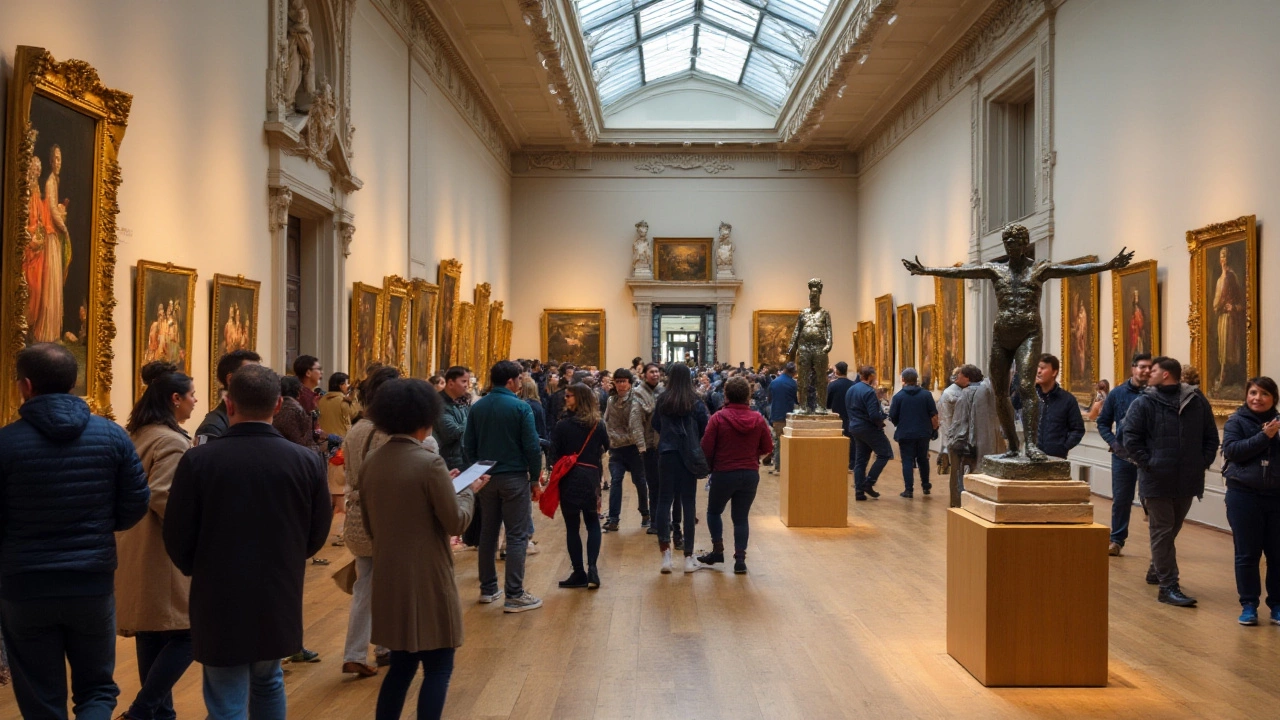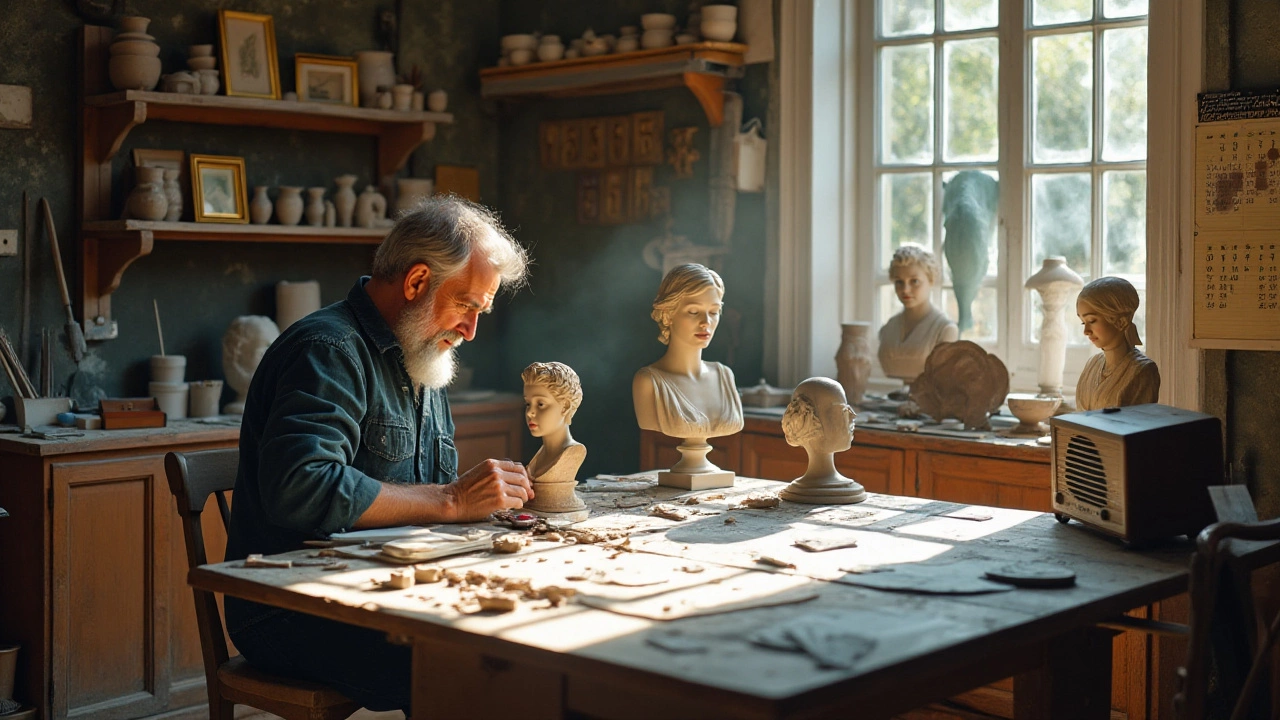Sculptures, standing as three-dimensional art, capture the human eye and spirit in unique ways. Yet, arriving at a price for these art pieces isn't as straightforward as it may seem. It involves a careful examination of several interconnected factors.
For both seasoned collectors and new artists, understanding these elements can be the key to appreciating or, potentially, purchasing these one-of-a-kind pieces. From the types of materials used to the artist's standing in the art community, every detail counts. Recognizing these factors helps navigate the often opaque world of art pricing.
- Understanding Material Costs
- Evaluating the Artist's Reputation
- Considering the Size and Complexity
- Market Demand and Trends
- Commission and Gallery Fees
- Tips for Emerging Artists
Understanding Material Costs
Creating a sculpture is a process deeply intertwined with the choice of materials, which significantly impacts the pricing. The variety of materials, ranging from traditional choices like marble and bronze to contemporary options such as stainless steel and mixed media, each carries its own cost considerations. Marble, renowned for its timeless elegance, not only incurs costs due to its rarity and labor-intensive nature but also because of the expertise required to sculpt it. Similarly, bronze, often chosen for its durability and the detail it can convey, involves a costly process known as casting. This technique, although it yields beautiful results, adds layers of expense, factoring in not just the raw material but the craftsmanship involved.
Emerging trends in the art market have introduced new materials like recycled objects or unconventional composites, often appealing to environmentally-conscious collectors. Artists using such materials must consider both the initial acquisition cost and the time invested in sourcing and preparing these elements. Additionally, shipping and handling of sculptures, especially larger ones, is a cost not to be overlooked. Transportation requires special packaging to prevent damage, and large-scale pieces may need professional movers and potentially cranes. It's vital for both artists and purchasers to be aware of these hidden fees as they contribute significantly to the end price. Interestingly, Christie's Auction House highlighted that "the material, though a crucial factor, becomes a vessel for the emotional and intellectual resonance of the piece," emphasizing its less tangible yet potent role in art valuation.
"Understanding the cost dynamics of materials in sculpture informs both artistic choices and market positioning," says a renowned art critic, shedding light on why these costs matter beyond the obvious.
Sculpture materials also link directly to the sculpture's longevity, as certain materials like marble endure without blemishing through centuries, offering a unique allure for potential investors looking at longevity and legacy. Long-lasting materials not only enhance the piece’s value but also align with expectations around its preservation. Meanwhile, new-age sculptures showcasing ephemeral materials such as ice or biodegradable components challenge traditional pricing structures but often drive interest due to their innovative nature. Therefore, understanding material choice and its implications on sustainability offer rich insights into pricing sculpture art.
Evaluating the Artist's Reputation
In the vast and varied world of sculpture pricing, the artist's reputation often plays an integral role, influencing the value of their work significantly. This reputation is not built overnight; it is an amalgamation of years of dedication, exhibited works, and critical receptions. A known artist, one who has established a strong presence in the art community, generally has a different market position compared to emerging talent. Collectors often seek out pieces from names that resonate with the art world's history and culture, knowing that these pieces not only bear artistic merit but also promise appreciation over time.
Historical context is vital when considering an artist's reputation. If the artist has works in prominent collections or has been part of significant exhibitions, those accolades add weight to their name and, consequently, to their creations. For instance, an artist who has been featured at the prestigious Venice Biennale is likely to command higher prices due to the international recognition and scrutiny of this event. Additionally, being represented by renowned galleries can serve as a badge of credibility and guarantee of quality. These galleries, acting as gatekeepers, selectively choose artists whose work they believe in, which can further enhance the artist's standing and perceived value.
Critical acclaim also plays a crucial role. Art critics, curators, and historians who discuss and analyze an artist's work can impact public perception. Favorable reviews can serve as endorsements, attracting collectors who trust these expert opinions. When a critic from a respected publication like Artforum or The New York Times praises an artist, it can open doors to new opportunities and elevate market interest. In some cases, these reviews can ignite a surge in demand, reflecting immediately on the artist's pricing.
That said, an artist's reputation is also rooted in their originality and contribution to the field. Artists who bring something novel, challenge conventions, or provoke thought often find themselves at the center of attention. An innovative sculptor who introduces a fresh technique or themes that resonate with contemporary issues might find their works more in demand. As the art landscape evolves, collectors are often eager to identify and invest in these pioneers.
Engagement with the community is another critical factor. Artists who actively participate in workshops, symposiums, or give talks can bolster their standing. This visibility builds a connection with both peers and the public, enhancing their name recognition. Artists like Ai Weiwei use social platforms not only to showcase their work but to engage in cultural dialogues, further solidifying their presence and influence.
Art valuation can be a nuanced and ever-changing phenomenon. An artist's peak in reputation might be reflected through auction records or sales history. Pieces that fetch impressive sums at auctions, such as those conducted by Sotheby's or Christie's, serve as benchmarks in valuing other sculptures by the same artist. Regularly achieving high sales figures can mark an artist's consistent value and demand.
"An artist’s name is the tip of an iceberg, built on years of unrelenting work, reflecting not just skill but their journey," remarked Marina Abramovic in a 2020 interview, highlighting the depth and complexity embedded in the value of an artist's name.
In summary, the journey of evaluating an artist's reputation is multifaceted. It spans historical significance, critical acclaim, innovation, community engagement, and market performance. Recognizing these elements when determining sculpture pricing not only leads to informed decisions but highlights the profound impact an artist's name can have in the art world. Such assessments, when done thoughtfully, respect the delicate balance between art as a passion and a prized possession.

Considering the Size and Complexity
The dimensions and intricacy of a sculpture often serve as telltale markers of its value. Size, while not the sole determinant, has a notable influence on sculpture pricing. Larger works require more raw material, extended production times, and often leverage specialized techniques. For instance, bronze sculptures, a popular choice, involve meticulous casting processes, which add layers of complexity and labor costs. Intricate detailing might also imply months, if not years, of dedicated work by the artist, factoring into the final price tag.
Complexity isn't just about the physical representation; it extends to the conceptual underpinnings of the art. Works that push boundaries, challenge norms, or incorporate innovative methods can command higher prices due to their uniqueness. The interplay of an artwork's tactile details—its textures, hidden nuances, or dynamic compositions—captivate collectors, drawing them into deeper reflection and appreciation. As renowned sculptor Louise Bourgeois once observed, "Art is a privilege and a responsibility. In sculpture, each gesture holds the weight of its thought."
Market insights reveal a fascinating pattern; collectors often equate size with investment potential, especially for pieces destined for public spaces or corporate displays. A grand sculpture can transform environments, making monumental pieces attractive to buyers with a grand vision. Yet, it's paramount to remember that diminutive, intricate sculptures, such as those created by Auguste Rodin, have historically captivated hearts, continuing to fetch impressive prices at auctions decades after their creation.
To assist emerging artists or buyers keen on understanding these nuances, a detailed consideration of logistical aspects is beneficial. Large sculptures necessitate special shipping arrangements, tailored display environments, and may even require permits for installations in particular locales. For collectors, awareness of these factors aids in making informed buying decisions, ensuring the artwork remains well-cared for as its value appreciates.
Market Demand and Trends
When it comes to pricing a sculpture, attentiveness to current market demand and prevailing trends is essential. Markets for art are as dynamic as they are diverse, with tastes that can pivot rapidly based on numerous influences, including cultural movements and even socio-political climates. For instance, sculptures that capture the zeitgeist of environmental consciousness have seen a surge in popularity. Buyers today are often drawn to works that speak to ecological sustainability, which, in turn, affects their willingness to pay certain premiums. Understanding these subtleties is crucial for both sellers and artists as they decide on a sculpture's worth.
The ebb and flow of art markets can also be impacted by celebrity endorsements and public exhibitions. When high-profile figures publicly acquire pieces or when sculptures gain visibility through well-attended exhibitions, this can significantly boost demand. Such was the case when renowned galleries showcased certain sculptures that echoed themes of identity and social justice, compelling a ripple effect in market valuations. Even trends in fashion and home decor, where minimalistic or nature-inspired aesthetics become popular, may influence the perception of a piece's value.
"The art market doesn’t move in straight lines; it’s often a mosaic of cultural and socio-economic tendencies," notes art market analyst Jessica Craft.
Historical sales data presents valuable insights for accurately gauging how similar sculptures have fared in the marketplace. This data helps shape predictions concerning future sales, offering benchmarks for artists and collectors alike. By examining auction results and gallery sales records, one can discern patterns that may affect pricing. Moreover, it's beneficial to analyze demographics of interested buyers and their purchasing behaviors, as these can serve as indicators of which trends might sustain or diminish.
The advent of digital platforms and virtual galleries has also introduced new dynamics to art markets. A vibrant online art scene enables sculptures to reach global audiences, diversifying demand but also heightening competition. While this globalization presents exciting opportunities, the challenge lies in accurately tapping into varied tastes and pricing accordingly. Historically localized trends can now influence broader markets, making it imperative for artists to stay informed through international exhibitions and digital galleries.

Commission and Gallery Fees
Navigating commission and gallery fees is an integral part of the art world, often overlooked by beginners. When entering a gallery, a sculpture is subject to various costs that artists need to account for. Galleries typically charge a commission on every piece sold, which can range from 30% to 50% depending on the prestige of the gallery and the legitimacy it provides to an artist. This means if a sculpture is priced at $10,000, the gallery could retain up to $5,000 from that sale. Understanding this dynamic properly illuminates why artists often price their pieces seemingly higher than anticipated.
Most galleries justify their commission fees by stressing their role in promoting and marketing the artist's work. They bear costs for organizing exhibitions, inviting potential buyers, and maintaining a reputation that can elevate an artist's credibility. Some galleries have historical significance, being known as the place where emerging artists have turned into renowned figures. A quote from influential gallerist, Marian Goodman, once mentioned,
"A gallery stake is more than financial; it's a commitment to nurturing the artist's journey."
This relationship can be symbiotic yet needs clear communication. Artists should be proactive in understanding what the gallery offers, as well as establish clear contractual terms about how exhibition expenses might affect the final amount recouped from sales. This clarity helps prevent unexpected deductions from what artists might see as their rightful earnings. Interestingly, data from a 2023 Art Basel report revealed that almost 60% of artists found gallery exhibitions instrumental in establishing market demand and visibility.
Costs Beyond Commission
Besides the commission, there are often hidden costs artists must brace for. Some galleries might charge participation fees for special exhibitions, while others opt for inclusive commission arrangements. Procedures around transportation, insurance, or potential installation costs at the gallery may also impact the overall fiscal outcome. Essentially, all these additional expenses play a crucial role in how a sculpture finally gets priced at market levels.
Being strategic about which galleries to collaborate with can pay dividends in terms of exposure and financial returns. While new artists sometimes bypass galleries to sell directly online, the allure of a gallery endorsement, despite the cost, remains tenacious. Prospective buyers look at a gallery's history and how it might align with their taste before considering a purchase. Hence, despite potential extra costs, these associations sometimes enhance an artwork's perceived value beyond imagination.
Tips for Emerging Artists
Stepping into the world of art with a fresh pair of eyes and an eager heart is exhilarating yet daunting. Emerging artists often wonder how to price their own creations, particularly when dealing with sculptural art. Establishing the right price can seem like an enigma wrapped in financial stress and creative pride. One essential step for artists is to familiarize themselves with the medium's market size. Knowledge is power, and by analyzing current market conditions, artists can gauge the demand for sculptures similar to their own. From the choice of material to the intricacy of design, each component plays a significant role in pricing. An artist needs to understand these elements before setting a price to ensure they do not undervalue their work.
Creating a network of contacts can immensely help. Engage with other artists and industry professionals to gain insights on pricing dynamics. Galleries are often the best place to showcase and sell artwork, but they take a portion of the sale which must be factored into the pricing strategy. This demands a keen balancing act between fair pricing and profitable returns. Establishing nourishing relationships with gallery owners can aid this balance. Moreover, branding oneself as an artist becomes crucial. Having a distinct, recognizable style can elevate an artist's reputation, influencing buyers to see greater value in their work. The internet offers tremendous opportunities for artists to present their portfolios to a global audience, making it a key tool for modern art branding.
In the art world, comparisons are both inevitable and necessary. Investigate what peers are pricing their sculptures at, ensuring to consider the variations in experience and audience size. Often, a piece's complexity, the time invested, and the artist's acclaim determine its pricing brackets. The breadth of this research adds layers of confidence to the art of pricing. Just as important as external diligence is an artist's internal compass. An honest assessment of one's expertise, time spent on creation, and personal financial requirements should inform the pricing decision. A valuable piece of advice comes from the respected sculptor Antony Gormley, who once noted,
"Art doesn't become valuable because of what someone proposes it's worth; it's valued intrinsically through the perception of those who appreciate it."
While setting a price for their creations, artists should also consider leveraging social media and online art platforms. Websites like Etsy, Saatchi Art, and Artfinder allow artists to reach broader audiences without the hefty fees that galleries might charge. The inclusion of professional photographs and engaging descriptions can enhance an online audience's appreciation of the artist's vision, significantly impacting pricing perception. Keep abreast of the technological advancements transforming the art world, such as NFTs, which offer new ways to value and sell digital or digitally-backed sculptures. Remaining adaptable and open to innovative platforms may open up new revenue streams and broader market acceptance.

